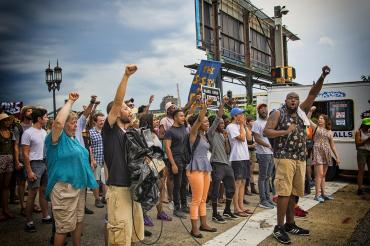To improve race relations, understand intent: U of T research

Published: September 15, 2016
Improving race relations starts with understanding whether people feel an incident of racial discrimination was intentional or not, a new U of T study says.
The findings apply to everything from interactions between police and protestors at demonstrations to workplace relationships, says Sonia Kang, assistant professor of management at U of T Mississauga.
Typically two approaches are applied to improving race relations, Kang says. A multicultural approach which uses education to highlight and celebrate differences in a group or a colourblind approach that emphasizes commonalities groups might share.
“Both approaches can and will work – the difficulty is identifying which approach to use. We wanted to know if there were variables that would help predict when one of those two approaches would be better to use.”
Kang, who is also appointed to U of T's Rotman School of Management, found that it is important to determine how a target group feels about the issue at hand, specifically whether they feel discrimination is intentional or unintentional.
“Does the incident stem from intentional and deliberate malice, or does it arise from unintentional or accidental ignorance?” Kang asks.
“We found that perceptions of intentionality predicted the kinds of solutions people think will be effective,” she says, adding that intentionality is important in a legal context for punishments in criminal cases.
“Even small kids will think about intentionality – did someone push them on purpose, or was it an accident?”"

Her study finds that when people see discrimination as intentional, they prefer a colourblindness approach, which encourages looking beyond racial differences. But when people see discrimination as unintentional, they prefer a multicultural approach, which encourages recognizing racial differences.
The paper reports on eight studies which examined a number of different predictors and outcomes, including attitudes about the recent events in Ferguson, Missouri.
The studies recorded how participants reacted to scenarios describing incidents of racial discrimination. In one example, participants were asked to award damages to an employee who had been wrongfully dismissed. Where the discrimination was perceived as intentional, study participants awarded an average of $100,000 more in damages than in scenarios where the discrimination was perceived as unintentional.
“There isn’t a one-size-fits-all approach,” Kang says. “But understanding whether people think racism is intentional or not can inform which is the best approach to deal with the issue at hand. It’s important to tailor your approach to what’s going on in the individual community you’re trying to target. If, for instance, you’re an employer and want to solve problems in your workplace, you will need to do a careful assessment of where your employees think the problem originates.”
“From ignorance to intolerance: Perceived intentionality of racial discrimination shapes preferences for colorblindness versus multiculturalism” was published in the Journal of Experimental Social Psychology.



